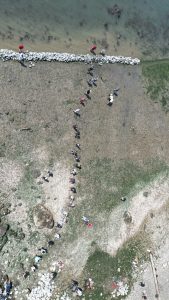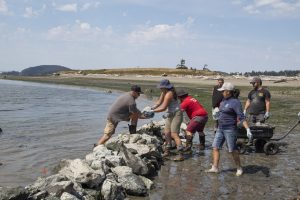The Swinomish Indian Tribal Community’s clam garden reclaims an ancient Indigenous practice on ancestral land
By Samantha Larson, WSG Science Writer

The Swinomish Indian Tribal Community and guests building the clam garden wall. Photo courtesy of the Northwest Indian Fisheries Commission.
From one set of hands to another, each rock was passed down the human chain from the beach to the sea. Some of the rocks could be held in one palm and easily passed. Others were the size of small boulders, requiring strong posture and extra exertion to settle the rocks into their place in the wall. Together, the Swinomish Indian Tribal Community and guests created history on the beach. In two-days, about 60 people worked to build a wall in the intertidal to become the first modern-day clam garden in the U.S.
After years of research and planning, the Swinomish Indian Tribal Community laid the first rocks of their clam garden on Kiket Island in August 2022. On the first day, Swinomish Tribal members worked to assemble the wall’s foundation. On day two, the Tribe invited members of their broader community to participate in the effort, including funders and partners, such as Washington Sea Grant (WSG). “Gathering like this is important to us,” said the late Larry Campbell (wanaseah), a Swinomish tribal Elder and community health specialist. “I want to thank each and every one of you that is here to witness our work. We hope we can all develop this process so that it can become a model for the rest of the world.”
Clam gardening is an Indigenous practice among Northwest coastal communities for more than 4,000 years in which habitat modifications sustainably increase shellfish production and species diversity. As the oceans continue to warm and grow more acidic, clam gardens have the potential to mitigate stressors in the salt water, and strengthen community resilience by securing connections and bolstering access to traditional foods that are vulnerable to these environmental changes. The clam garden’s rock wall will create an intertidal terrace in which marine life can find nutrients and shelter. “Ecological studies have documented significantly higher densities of native littleneck and butter clams in historic clam gardens compared to unmodified beaches,” explained Courtney Greiner, a marine ecologist for the Swinomish Tribe.
Despite thousands of years of care and observation, social factors including colonialism, forced assimilation and shoreline development threatened these and other cultural practices, with impacts on communities and coastal landscapes over the past century. While there were once hundreds of clam gardens along the coasts from modern-day Alaska to Washington, over the years many of them fell fallow as Indigenous caretakers were displaced or their cultural and spiritual practices were banned.
For many members of the Swinomish Tribe, building a clam garden not only revives a traditional practice innovated by their ancestors, but is also a powerful process of healing from the social and cultural harms of the past hundred and fifty years. Kiket Island where the clam garden is now located was part of the land reserved by the Swinomish people when they signed the 1885 Treaty of Point Elliott. However, the uplands fell into non-native ownership and Tribal members were aggressively deterred from accessing Kiket’s shores. “I used to come out here to dig clams in the 1980s,” one Swinomish Tribal member recalled. “They had guns and big dogs and chased us away all the time.”
In 2010, the Swinomish Tribe worked with the Washington State Parks and Recreation Commission to jointly acquire the upland area — what’s now known as Kukutali Preserve. The stewardship of Kiket Island is once again in the hands of Tribal members.
When the Tribe began to consider building a clam garden, the area became one of several locations under consideration. With funding and research support from WSG, the Tribe’s Fisheries Department and Community Environmental Health Program gathered guidance from Indigenous knowledge holders and clam garden researchers to help determine which site would maximize the ecological and socio-cultural benefits of the clam garden. “The Swinomish Indian Tribal Community demonstrated a model to integrate social and ecological information with Indigenous knowledge,” said Melissa Poe, a social scientist at WSG who collaborated on the project. “This is a practical and transferable tool for other place-based restoration decisions that centers community priorities and leadership, which in this case includes increasing access to ceremonial and subsistence foods, as well as sharing knowledge across generations within the community, among other goals.”
This collaborative approach that embraces Indigenous knowledge and priorities was important to many Tribal members and can be a model for other efforts. “We are working to blend the Western science and the Tribal science,” said Campbell. “The tribes don’t need to be isolated. They need to be part of the bigger questions and the bigger work.”
 In late 2021, the Swinomish Tribe received funding from the NOAA Saltonstall-Kennedy Competitive Grants Program and from the Northwest Climate Adaptation Science Center to begin building the clam garden. It began the following August with a delivery of 35 tons of rocks onto Kiket’s shores. All of the rocks had been collected from the Swinomish’s ancestral territory. “It was important to us that the rocks come from our ancestral territory. This was much bigger than the reservation — the reservation was where we were moved once everything was stolen from us,” said Swinomish Vice Chair Alana Quintasket (siwəlcəʔ). “This is about restoring our relationships with faith, and with place.”
In late 2021, the Swinomish Tribe received funding from the NOAA Saltonstall-Kennedy Competitive Grants Program and from the Northwest Climate Adaptation Science Center to begin building the clam garden. It began the following August with a delivery of 35 tons of rocks onto Kiket’s shores. All of the rocks had been collected from the Swinomish’s ancestral territory. “It was important to us that the rocks come from our ancestral territory. This was much bigger than the reservation — the reservation was where we were moved once everything was stolen from us,” said Swinomish Vice Chair Alana Quintasket (siwəlcəʔ). “This is about restoring our relationships with faith, and with place.”
After the work of moving the rocks that day, the people gathered in a circle to share their reflections on the experience. The feelings of hope, inspiration and connection were palpable. Members of Malahat First Nation were present, in part to learn about the process as they consider restoring a clam garden of their own. “There are no words for what’s going on today. This is only the beginning,” said George Harry, Malahat Chief. “The knowledge is coming back. The language is coming back. Everybody left their hearts on the beach, and our ancestors are watching us.”
In the time since the August event, Swinomish members and their community have continued to build and tend to the clam garden, and it has continued to be a space for community and connection. Many Swinomish members are hopeful this arc of repairing and rebuilding will extend well into the future. For example, the Swinomish Tribe plans to host a Salish Summit to gather Indigenous aquaculture practitioners from across the Pacific Basin. The Summit is part of the Indigenous Aquaculture Collaborative, a community of practice that is coordinated by Melissa Poe of WSG.
“What you accomplished today is something that’s going to be here for generations. For thousands of years. You created history,” said Steve Edwards (yal lə ka but), Chairman and member of the Swinomish Tribe. “Something was taken away, many generations ago, and you’ve restored it.”
www.wsg.uw.edu
Join the conversation: @WASeaGrant and Facebook.com/WaSeaGrant.
JUN
2023